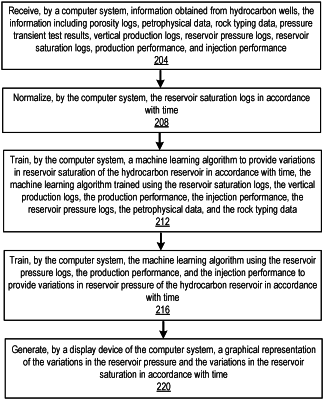| CPC G06N 20/00 (2019.01) [G01V 99/005 (2013.01); G06F 30/27 (2020.01); E21B 2200/20 (2020.05)] | 20 Claims |

|
1. A method comprising:
receiving, by a computer system, information obtained from a plurality of hydrocarbon wells, the information comprising porosity logs, petrophysical data, rock typing data, pressure transient test results, vertical production logs, reservoir pressure logs, reservoir saturation logs, production performance, and injection performance;
normalizing, by the computer system, the reservoir saturation logs in accordance with time;
training, by the computer system, a machine learning algorithm to provide variations in reservoir saturation of a hydrocarbon reservoir in accordance with time, the machine learning algorithm trained using the reservoir saturation logs, the vertical production logs, the production performance, the injection performance, the reservoir pressure logs, the petrophysical data, and the rock typing data, wherein the training combines unsupervised learning and supervised learning;
training, by the computer system, the machine learning algorithm using the reservoir pressure logs, the production performance, and the injection performance to provide variations in reservoir pressure of the hydrocarbon reservoir in accordance with time, wherein the training combines unsupervised learning and supervised learning;
generating, by a display device of the computer system, a graphical representation of the variations in the reservoir pressure and the variations in the reservoir saturation in accordance with time; and
infill drilling at locations of the hydrocarbon reservoir to target areas of the hydrocarbon reservoir associated with an increased sweep efficiency.
|